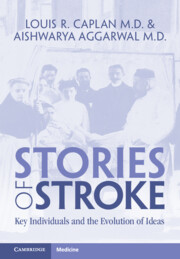Book contents
- Stories of Stroke
- Stories of Stroke
- Copyright page
- Contents
- Contributors
- Why This Book Needed to Be Written
- Preface
- Part I Early Recognition
- Part II Basic Knowledge, Sixteenth to Early Twentieth Centuries
- Chapter Four Andreas Vesalius
- Chapter Five William Harvey
- Chapter Six Thomas Willis
- Chapter Seven Giovanni Morgagni
- Chapter Eight Apoplexy
- Chapter Nine Atlases
- Chapter Ten Brainstem Syndromes
- Chapter Eleven Jules Dejerine
- Chapter Twelve Arterial and Venous Anatomy
- Chapter Thirteen Rudolf Virchow
- Chapter Fourteen Early Medical and Neurological Textbooks
- Part III Modern Era, Mid-Twentieth Century to the Present
- Part IV Stroke Literature, Organizations, and Patients
- Index
- References
Chapter Eight - Apoplexy
Ideas and Concepts, Seventeenth to Twentieth Centuries
from Part II - Basic Knowledge, Sixteenth to Early Twentieth Centuries
Published online by Cambridge University Press: 13 December 2022
- Stories of Stroke
- Stories of Stroke
- Copyright page
- Contents
- Contributors
- Why This Book Needed to Be Written
- Preface
- Part I Early Recognition
- Part II Basic Knowledge, Sixteenth to Early Twentieth Centuries
- Chapter Four Andreas Vesalius
- Chapter Five William Harvey
- Chapter Six Thomas Willis
- Chapter Seven Giovanni Morgagni
- Chapter Eight Apoplexy
- Chapter Nine Atlases
- Chapter Ten Brainstem Syndromes
- Chapter Eleven Jules Dejerine
- Chapter Twelve Arterial and Venous Anatomy
- Chapter Thirteen Rudolf Virchow
- Chapter Fourteen Early Medical and Neurological Textbooks
- Part III Modern Era, Mid-Twentieth Century to the Present
- Part IV Stroke Literature, Organizations, and Patients
- Index
- References
Summary
Sudden or protracted loss of bodily motion and functions has fascinated physicians throughout history. Coma, stupor, and paralysis are difficult conditions to ignore, especially when they develop suddenly. Apoplexy was a term introduced (possibly by Hippocrates) before the common era for such diverse bodily states. Since then many physicians have written about apoplexy: its definitions, concepts, phenomenology, examples, purported mechanisms, epidemiology, causes, and outcomes. I (LRC) will herein be eclectic, mentioning some contributions briefly but emphasizing individuals and ideas that had more important content and lasting influence.
- Type
- Chapter
- Information
- Stories of StrokeKey Individuals and the Evolution of Ideas, pp. 42 - 54Publisher: Cambridge University PressPrint publication year: 2022

